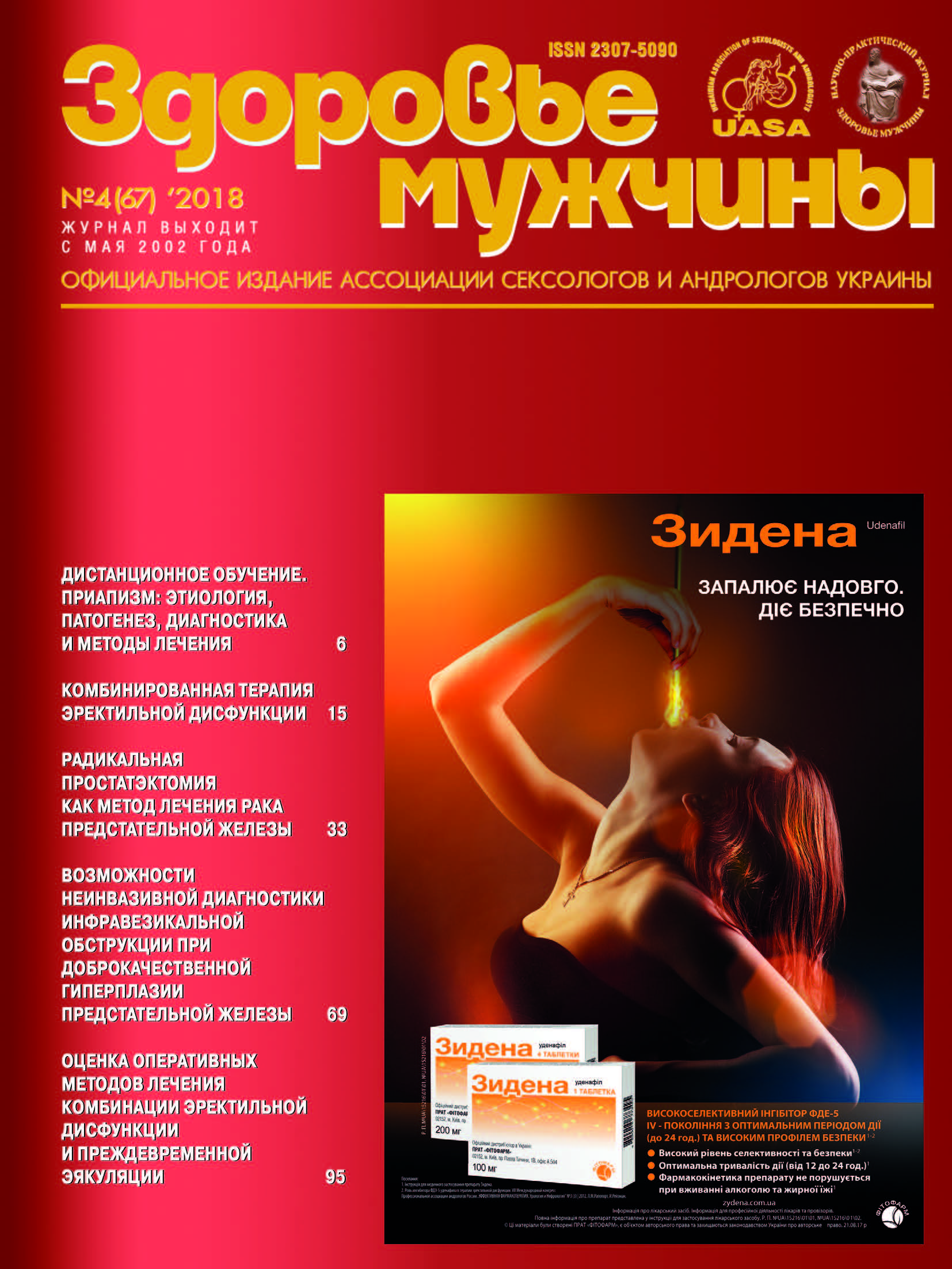Evaluation of the Efficacy of Canephron® N Herbal Medicine in the Complex Treatment of Urolithiasis Patients Using Remote Shock-wave Lithotripsy
##plugins.themes.bootstrap3.article.main##
Abstract
The study objective was to analyse the effect of the herbal drug Canephron N, namely, its ability to potentiate the efficacy of extracorporeal shock wave lithotripsy (ESWL) in the treatment of patients with urolithiasis (UL) and prevent recurrence of stone formation.
Aim. To сheck the hypothesis that treatment with Canephron N can potentiate lithotripsy and reduce the risk of re-stone formation.
Methodology. Patients at the age of 18 to 65 years had calcium oxalate urolithiasis with the size of the stone from 0.8 to1.3 cm in the kidneys and from 0.5 to0.9 cm. in ureters who underwent ESWL procedure. They were randomized into 2 equal groups of 30 people. The treatment group received general recommendations on the management of the patient with UL following ESWL and the herbal drug Canephron N for 6 months. The control group received only general recommendations. Moreover, according to condition, both groups received painkillers and spasmolytics if pain occurred during elimination of fragments. The following parameters were evaluated: the period of elimination of fragments after stone disintegration by ESWL method; the percentage of complete elimination of fragments; the presence of pain syndrome and leukocyturia in the postoperative period; the rate of recurrence of stone formation during one year after the procedure.
Results. More complete and rapid elimination of fragments was observed in the treatment group. Thus, up to day 14 elimination of stone fragments was observed in 96.6 % of patients in the treatment group versus 76.6 % in the control group. Fewer cases of pain syndrome during elimination of stone fragments (23 % in the treatment group and 43 % in the control group) and rare cases of leukocyturia within 14 days (10 % versus 23 %, respectively) were observed in the treatment group. Recurrent stone formation within the year was not observed in patients of the treatment group, in the control group – in 23 % of patients. However, because of the small size of the groups, one may talk about a tendency but not about statistically significant patterns.
Conclusion. Canephron N is an effective and safe drug in the treatment of patients with urolithiasis who underwent extracorporeal shock wave lithotripsy. Its use contributes to more rapid and safe elimination of fragments of destructed calculi and reduces risk of recurrent stone formation.##plugins.themes.bootstrap3.article.details##

This work is licensed under a Creative Commons Attribution 4.0 International License.
Authors retain the copyright and grant the journal the first publication of original scientific articles under the Creative Commons Attribution 4.0 International License, which allows others to distribute work with acknowledgment of authorship and first publication in this journal.
References
Keoghane, S., Walmsley, B., Hodgson, D. (2009). The natural history of untreated renal tract calculi. BJU International, 105 (12), 1627–1629. https://doi.org/10.1111/j.1464-410X.2010.09389.x
Аляев Ю.Г., Амосов А.В., Газимиев М.А.. Ультразвуковые методы функциональной диагностики в урологической практике. М: «Р. Валент». 2010.
Аляев Ю.Г., Руденко В.И., (2016) Современные аспекты лекарственной терапии пациентов с мочекаменной болезнью. Эффективная фармакотерапия. Урология и нефрология, 5 (41) 10–16. PDF
Черепанова Е., Дзеранов Н. (2014) Метафилактика уролитиаза у амбулаторных пациентов. Здоровье мужчины, 4 (55), 96–100.
Давидов М.И., Игошев А.М. (2015). Влияние растительного препарата Канефрон Н на результаты дистанционной ударно-волновой литотрипсии. Здоровье мужчины, 4 (55), 96–100.
Ceban, E. (2012). Efficacy of a fixed combination of Centaurii herba, Levistici radix and Rosmarini folium in urinary lithiasis. Zeitschrift Für Phytotherapie, 33 (1), 19–23. http://doi.org/10.1055/s-0031-1286040
Tiselius, H-G., Alken, P., Buck, C., Gallucci, M., Knoll, T., Sarica, K., Türk, Chr. (2009). EAU Guidelines on urolithiasis. European Association of Urology, 116. PDF
Kok, D. J. (2015). The preventive treatment of recurrent stone-formation: how can we improve compliance in the treatment of patients with recurrent stone disease? Urolithiasis, 44 (1), 83–90. http://doi.org/10.1007/s00240-015-0842-9
Аляев, Руденко (2012). Растительный препарат Канефрон Н в лечении пациентов с уролитиазом. Урология, 6, 22–25.
Gaibulaev, A., Kariev, S. (2012). Effect of long-term Canephron N treatment on urinary risk factors associated with idiopathic calcium urolithiasis. Springer Medizin.
Naber, K. (2013). Efficacy and safety of the phytotherapeutic drug Canephron N in prevention and treatment of urogenital and gestational disease: review of clinical experience in Eastern Europe and Central Asia. Research and Reports in Urology, 5, 39–46. https://doi.org/10.2147/RRU.S39288
Григорян В., Амосов А. (2011). Применение Канефрона Н при уролитиазе. РМЖ, 16, 1033. Full text
Alelign, T., Petros, B. (2018). Kidney Stone Disease: An Update on Current Concepts. Advances in Urology, 2018, 1–12. https://doi.org/10.1155/2018/3068365
Strohmaier, W. L. (2000). Volkswirtschaftliche Aspekte des Harnsteinleidens und der Harnsteinmetaphylaxe. Der Urologe A, 39 (2), 166–170. http://doi.org/10.1007/s001200050026
Yeni, E et. al. (2003) 2 EULIS Meeting (The 10-th European Symposium on Urolithiasis). Istanbul, 348.
Trinchieri, A. (2006). Epidemiological trends in urolithiasis: impact on our health care systems. Urological Research, 34 (2), 151–156. https://doi.org/10.1007/s00240-005-0029-x
Kumarasamy, Y., Nahar, L., Sarker, S. (2003). Bioactivity of gentiopicroside from the aerial parts of Centaurium erythraea. Fitoterapia, 74 (1-2), 151–154. https://doi.org/10.1016/S0367-326X(02)00319-2
Ухаль М., Габчак Р., (2010). Применение препарат Канефрон Н в комплексе с бальнеотерапией у пациентов с уролитиазом. Здоровье Мужчины, 4, 117–121.
Ухаль М., Маломуж О., (2013). Современные возможности фитотерапии в послеоперационной реабилитации пациентов с уролитиазом, осложненным хроническим пиелонефритом. Урология, Нефрология, Андрология. Харьков, 196–200.
Gracza, L., Koch, H., Löffler, E. (1985). Über biochemisch-pharmakologische Untersuchungen pflanzlicher Arzneistoffe, 1. Mitt. Isolierung von Rosmarinsäure aus Symphytum officinale und ihre anti-inflammatorische Wirksamkeit in einem In-vitro-Modell. Archiv Der Pharmazie, 318 (12), 1090–1095. https://doi.org/10.1002/ardp.19853181207





